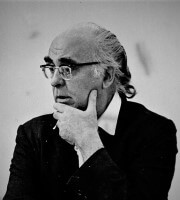About Charles Olson
Charles Olson (Worcester, December 27, 1910 - New York, January 10, 1970) was an American poet, essayist, academic representative of the post-modernist movement who launched the so-called progressive Black Mountain College, and later an archaeologist. In 1948, he obtained a teaching position at Black Mountain College, of which he was dean from 1951 to 1956. He made his debut in 1947 with Call me Ishmael, centered on the work of Herman Melville, of whom he was a scholar and fine connoisseur. By the end of the 1950s, he had established himself as the Black Mountain poet par excellence. Among his most famous works we can mention Call Me Ishmael (1947), Letter for Melville (1951), This (1952), The Maximus Poems (1953), The Distances (1960) and Human Universe (1965).Charles Olson had big aspirations, extensive intellect, and tenacious fervor in his role as a poet, literary evaluator and theorist, educator, and guide to emerging poets. His exceptional achievements in these domains distinguish him as one of the foremost figures of the influential Black Mountain school of poetry, and as one of the most dynamic and significant figures in American poetry during the mid-twentieth century. Olson was born in Worcester, Massachusetts, which was also the birthplace of his fellow poets and near contemporaries, Elizabeth Bishop and Stanley Kunitz. He obtained a B.A. and M.A. from Wesleyan University and initiated his Ph.D. in the newly established American studies program at Harvard University in 1936, but terminated it in 1938 without completing the degree.
Olson gained recognition as a literary critic with the publication of Call Me Ishmael (1947), which stemmed from his research on Herman Melville during his graduate studies. This work brought him significant attention in the literary world. In the early 1940s, Olson participated in Franklin Delano Roosevelt's campaign and served as assistant chief of the Foreign Language Division of the Office of War Information during World War II. He will also work for the American Civil Liberties Union to participate in anti-Nazi propaganda. His commitment pointed him out to the authorities of the Democratic Party, when he could have embraced a political career, in 1948, he returned to teaching as a professor at Black Mountain College to replace Edward Dahlberg. However, Olson left Washington in 1945 due to his objections to the more conservative direction he felt the Democratic Party was taking under Harry Truman's leadership. In 1948, he joined the faculty of Black Mountain College. There, Olson collaborated with poets such as Robert Creeley and Robert Duncan. From 1951 to 1956, Olson served as rector of Black Mountain College before it closed. In his influential essay "Projective Verse" (1950), Olson articulated the principles of the Black Mountain school, such as "open verse" and "composition by field." He believed that the poetic line should be associated with the breath of the poet and reader, and he explored the interplay between feeling and thought in his own poetry. While studying Mayan ruins in the Yucatán in the early 1950s, Olson corresponded extensively with Robert Creeley, and their letters were published as Mayan Letters (1953). During this period, Olson produced powerful poems such as "As the Dead Prey Upon Us," which was inspired by dreams of his deceased mother, and "The Distances," which explored the presence of mythic and historic figures in contemporary life.
As he worked on these new texts, Olson was also working on a new epic poem, “The Maximus Poems”, which focused on his native Gloucester, Massachusetts, the seaport town where he was adopted. The main character in the poem, Maximus, bears a strong resemblance to Olson himself. Indeed, the very title of the poem seems to refer to him: “Maximus,” at six foot eight inches tall, was a massive and imposing figure. Although Olson denied any direct connection, the Maximus Poems (presented here in the form of “The Songs Of Maximus”) appear to be heavily influenced by Ezra Pound's Cantos, and William Carlos Williams' Paterson, both in their focus on the poet as a legendary figure and their preoccupation with the role of history and place in the relationship between myth and person. After a few years of seclusion in Gloucester, he returned to teaching at the University of New York at Buffalo, where he re-emerged as an influential figure.
His final years were troubled by alcoholism, and he died in 1970 of liver cancer, but not before completing the third and final edition of his Maximus Poems, and Olson remains one of the most important figures in American letters: a poet, a teacher, and a critic who inspired poets of his generation and who continues to inspire poets today.
Browse all poems and texts published on Charles Olson
The poem, for me, is simply the first sound realized in the modality of being.









